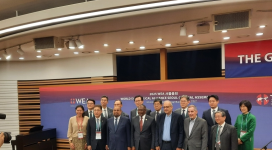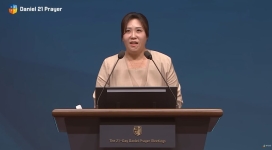The Structure and Process Study Group (SPSG), which has been in charge of developing a proposal for denominational structure, presented a report and recommendations to the American Baptist Churches (ABC) USA General Board during semi-annual sessions.
The General Board unanimously affirmed the SPSG's proposed action: "To affirm the direction of these recommendations as having sufficient validity to proceed with denomination-wide discussions, additional development and specific action proposals to be brought back to the General Board for First and Second Readings at subsequent meetings."
The SPSG, in its introduction to the report, detailed the process leading up to its report, and offered a proposal for next steps:
"The General Board formed the Structure and Process Study Group in November 2000 to 'further develop and recommend to the General Board next steps for addressing the issues and direction proposed' by the Review Commission on Denominational Structure and Process. The Review Commission was originally formed by the General Board in November 1997 to fulfill the ABC Standing Rule 11.2.6 (d) requirement for 'regular General Board assessment of the structure and process of the ABC/USA.'"
"The SPSG submitted a progress report at the June 2002 General Board meeting and was granted authority to hold one additional meeting to develop an organizational design. The goal of these recommendations is to fulfill the General Board's assignment by addressing the issues raised by the original Review Commission in a manner that receives widespread support across the denomination and will serve the ABC well in the years to come."
"These recommended changes in board governance and staff responsibilities are not copied from any other organization, but rather attempt to be consistent with ABC identity and to be effective in bearing witness to Jesus Christ in all the world. The SPSG has attempted to incorporate the best possible organizational structures and processes to achieve effective collaboration, cooperation, and stewardship of resources."
Rationale: The rationale for change that guided the SPSG included:
* strengthen the identity of the ABC and set the vision
* provide more coordination
* provide more effective and efficient means for allocating resources to priorities
* provide for more accountability
* maintain a balance of power and authority
Consensus: The SPSG operated on a consensus model to move recommendations forward with the widest possible support. The following 'levels of consensus' indicators were used for monitoring the sense of the group at decision points:
1. Absolute support for the decision
2. Strongly in support with some mild reservations/concerns
3. Moderate support with significant concerns
4. Serious concerns but will go with the wisdom of the group (non-blocking)
5. Serious concerns that require a veto/blocking of the decision
6. Not enough information to make a decision
"These recommendations reflect the consensus reached by the SPSG at its meeting on November 1, 2002."
"Next Steps: Some of these recommendations may be implemented immediately. Some will require Standing Rules changes, and some will require amendments to the Bylaws (at the 2005 Biennial convention). At this time, the SPSG is seeking the General Board's questions and affirmation of the direction of these recommendations, recognizing that specific action proposals would be brought back to the General Board by the SPSG Design Team for first and second reading at subsequent meetings."
"Proposed Action: To affirm the direction of these recommendations as having sufficient validity to proceed with denomination-wide discussions, additional development and specific action proposals to be brought back to the General Board for First and Second Readings at subsequent meetings."
"Thank you for the opportunity to serve in this task as we seek to enhance the future effectiveness of our collective ministry and mission."
"Members of the SPSG: Timothy Bonney, Samuel Chetti, Herschell Daney, Harold Davis, Beverly Davison, Daris Dixon-Clark, Jean Doirin, Joan Firster, James Foster, Gladys Gray-Board, Sumner Grant, David Hunt, Ron Johnson, Trinette McCray, Roy Medley, Les Rempel, Daniel Rawleigh, Linda Spoolstra, Dwight Stinnett, John Sundquist, Gene Ton, Cheryl Wade, and Aidsand Wright-Riggins."
The text of the Study Group's report follows:
RECOMMENDATIONS OF THE STRUCTURE AND PROCESS STUDY GROUP
"The General Board is the governing body responsible for setting the ABC mission, vision and policy at the denominational level. In addition, the General Board approves all budgets, determines priorities, allocates unrestricted funds, coordinates and assigns functions and evaluates how well the mission, policies, and assignments are being achieved."
"When the General Board convenes, it would be convened concurrently as the five historic corporations. The General Board will divide its members into four groups. The first group will have the primary function of developing mission and vision and performing oversight and evaluation at the denominational level. The other three groups will be the program units of International Ministries, National Ministries, and Educational Ministries. (The division of the General Board into these four groups may be done by equally dividing the membership of the General Board into four groups, or may be done according to need)."
"The role of each of the program units is to carry out the mission and vision established by the ABC General Board as one of its incorporated program units. The program units accomplish the strategic planning and implementation of the MACRO vision at the micro level. Each program unit will retain its current incorporation along with charter goals, endowments, and dollars allocated to it. In addition, the program unit will recommend officers from among the members assigned to the unit and these officers will be elected by the General Board. The chair of the program unit shall be a vice president of ABCUSA (in addition to the current ABC officer positions). The program units will propose, develop, and manage the budgetary resources allocated to them (unrestricted funds and restricted donor funds) by the General Board. Donor intent will continue to be honored. The program units are the first level of accountability for program and staff."
"The General Secretary is the primary staff officer to the General Board. The Executive Directors/National Secretaries are primary staff to the program units."
"The Executive Directors/National Secretaries are directly accountable to the General Secretary for carrying out the denominational mission vision and implementation of policies, as established by the General Board. It is important to understand that the intent is to clarify lines of accountability, not to diminish the role of the Executive Directors."
"The Executive Directors/National Secretaries are nominated by the General Secretary in consultation with an advisory search committee from the program unit and are called by the General Board (by a 2/3rds vote). Removal of an Executive Director/National Secretary for cause can be initiated by a request from the program entity through the General Secretary or directly by the General Secretary. The call for removal must then be ratified by a simple majority vote of the General Board."
"The Staff Leadership Council (SLC) supports the General Board. The SLC is composed of the General Secretary, the Associate General Secretary/Treasurer, the Executive Directors/National Secretaries, and four Regional Executive Ministers (nominated by the General Secretary, confirmed by the Regional Executive Ministers Council). The General Secretary convenes the SLC. The SLC supports the General Board in its policy/macro-planning role. It also has primary responsibility for implementing the policies/plans of the General Board. The General Secretary may bring additional ad hoc members to the SLC depending on need. All members of the SLC bring the wisdom and information of their home organization, but do not act solely as formal representatives of that group. Instead, they agree to also represent the larger general needs of the denomination in their decision-making. There will be a dotted-line relationship between the SLC and the Regional Executive Ministers Council such that there will be closer meaningful communication between the two organizations but no authority relationship between the two."
"The General Executive Council will continue to exist, but its role will be partially subsumed by the functions of the SLC. As a result, the General Executive Council will be convened on an "as-needed" basis rather than at regular intervals as is done currently."
"The Office of the General Secretary is staff to the General Secretary."
"An Administrative Services Unit shall be developed to cut costs, avoid duplication, and enhance effectiveness. Further discussion by the current National Executive Council is needed to determine:
* the list of services included in the unit (e.g., legal services, human resources, travel and conference planning, printing, video production and editing, editing, graphic arts, mailing and sales order processing, and computing services)
* whether the unit will be wholly incorporated or not
* the nature of the administration of the unit
A Ministerial Care Unit will be developed to foster greater cohesiveness in addressing the concerns and needs of ABC ministerial leaders. This unit could encompass the Commission on Ministerial Leadership, Interim Ministries, Women in Ministry, American Baptist Personnel Services, Chaplainry and Pastoral Counseling Services, and the Ministers Council. Further discussion is needed to determine:
* where the Department of Ministerial Care should be housed (the suggestions are within EM, NM or OGS)
* how the Department should be funded
"Each program unit will have its own treasurer and that treasurer will be an associate treasurer of ABCUSA. Together with the ABC Treasurer, they form the Treasurers Council."
"There was not sufficient time to clarify the structural relationship of all of the Administratively Related Organizations to the other structural components presented here."
"The Ministers and Missionaries Benefit Board will retain the same corporate and working relationship to the General Board as now."
American Baptist News Service (11/15/02)--The General Board of American Baptist Churches USA last night received for first reading the Common Budget Covenant that has been prepared and approved by the denomination's General Executive Council (GEC)."
The draft version of the Common Budget Covenant and the related Operating Guidelines are the result of a process spanning a decade that has included review of the existing Budget Covenant and the ultimate development of a proposed new covenant the GEC feels is more responsive to mission priorities and giving opportunities.
The new covenant presents two plans, the United Stewardship Plan and the Flexible Stewardship Plan. The GEC proposal calls for each of the 34 American Baptist regions to choose one. The United Stewardship Plan follows the general pattern of the current Common Budget Covenant, with United Mission a core component and with UM funding to American Baptist regions increased to 65%. Under the Flexible Stewardship Plan local churches determine the percentage allocation of their mission dollars and individualize their mission giving.
The Operating Guidelines provide the protocols for implementing the principles outlined in the covenant. Designed to be changed more readily than the Common Budget Covenant, the Operating Guidelines is the document where details responsive to changing situations and values are addressed.
All 39 covenanting organizations within American Baptist Churches USA must approve the Budget Covenant. The General Board will be the first of those organizations to consider changing the existing covenant. The GEC has set a target date of Jan. 1, 2004 to implement the provisions of the new covenant.
A second reading and subsequent action will be scheduled for a future meeting of the General Board.
By Albert H. Lee
editor@chtoday.com







